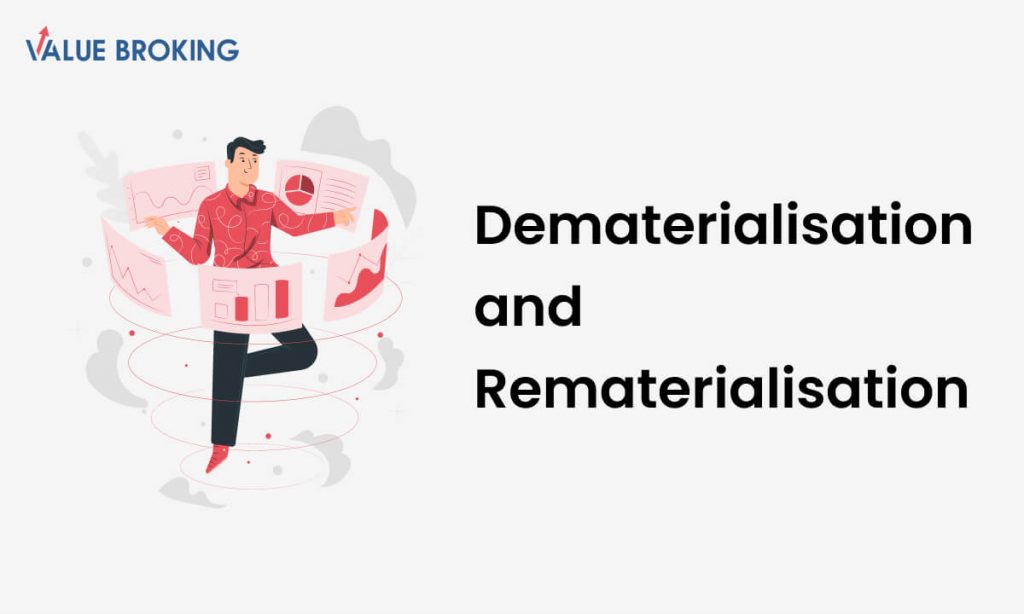Distinguish between Dematerialisation and Rematerialisation

For beginners, terms like dematerialisation and rematerialisation can be confusing. They can face some issues with the difference between dematerialisation and rematerialisation. Here you can understand the basics of both these options, and you can then decide which one you prefer. Both terms are important in investment and trading. We will learn about dematerialisation & rematerialisation.
Table of Contents
What is Dematerialisation and Rematerialisation?
The following is the primary explanation of dematerialisation and rematerialisation.
Dematerialisation
Dematerialisation is a systematic procedure through which the physical and paper documents of your shares, investments, and debentures get converted into an electronic format. In Dematerialisation, all the transactions proceed in electronic form. This procedure is beneficial as it makes the job of trading and investing through your internet devices easier for you since all the documents are available for you to access 24/7. It is also extremely helpful in decreasing fraud in investment because all your shares and securities transactions are available, and you can easily track their performance.
Rematerialisation
Rematerialisation is a systematic procedure through which an investor can convert their electronic forms of shares, funds, and debentures into physical or paper format. Investors often choose rematerialisation to avoid the AMC changes to the Demat account. You can apply for rematerialisation to the depository participant. You will have to submit the Remat Request Form (RRF). All transactions in Rematerialisation proceed in physical form.
How to Choose Between Dematerialisation & Rematerialisation?
The choice between dematerialisation & rematerialisation is entirely up to the investors. Some choose dematerialisation because they like the facilities like online trading. Then some may opt for rematerialisation as they wish to save their AMC charges or the traditional way of document keeping.
Many investors started trading and investing in the stock market due to the online availability of trading platforms, such as the apps and websites provided by various Demat and trading account providers, which allows them to trade as per their liking. It is also easier for them to sell and buy using online trading. However, some people are much more comfortable with the offline trading mode, as it does not require them to keep up with all the newly introduced technologies. Instead, they can simply trade and invest through the offline method.
You can say that two types of investors prefer two different types of trading and investing. Still, if you have only a single share in your account, you can get it rematerialised as you will have to pay the AMC charges regardless of the number of shares in your Demat account.
You need to understand both of them individually in detail for dematerialisation vs rematerialisation.
Step by Step Guide for Dematerialisation of Shares and Other Securities
As mentioned before, dematerialisation is a systematic process, and you will have to go through the step-by-step procedure to convert your documents into electronic format.
The following is the step on how to dematerialise your share, debenture, and bonds:
- The initial step is to open a Demat account; you can search for a broker or a DP who provides the facility of a Demat account, compare all the facilities provided by various DPs and then choose one among them to open your Demat account.
- Fill and submit the dematerialisation request form [DRF] to your DP, and ensure to write “Surrendered for Dematerialisation” on all your physical certificates.
- Your DP proceeds the request to the Depository, the registrars, and the transfer agent, with all your certificates.
- The registrar will notify your DP about the status of this process.
- After the confirmation for the conversion of your certificate, your documents will start reflected in your account.
You can even ask your DP for assistance regarding the dematerialisation of your documents, and they will also guide you throughout the process.
Step by Step Guide for Rematerialisation of Shares and Other Securities
There is also a step-by-step guide to the rematerialisation of your documents.
The following is the procedure for the rematerialisation of your shares, funds, and debentures:
- The investor must submit the DP’s rematerialisation request form (RRF).
- The DP will proceed with that form to the depository, and the depository will then move with your request form to the registrar.
- After this step, your DP will directly send your RRF form to the Registrar
- Once the registrar receives the request, he will thoroughly examine your request, print the paper or physical document of your certificates, and send them to you.
- After the registrar confirms your request form with the depository, you will get the new certificate with your DP.
During rematerialisation, you can take help from your DP through all the steps for rematerialisation. So it is just like dematerialisation.
Conclusion
Hopefully, you now understand how to distinguish between dematerialisation and rematerialisation. Finally, you have a basic understanding of how it functions.
Between dematerialisation & rematerialisation, investors have complete control over which one they want or choose. Moreover, they can decide which one suits their investment strategy the most.
Today, many youngsters choose dematerialisation over rematerialisation, but that is not always the case. The choice solely depends on what you are most comfortable with. For example, do you like the idea of trading from anywhere you want, or do you like to physically scrutinize the transition process of your shares, bonds, funds, and debentures?
Follow all the processes of the dematerialisation and rematerialisation of your documents correctly. Consult your DP regarding your questions and doubts. You are the owner of all the shares, debentures, and bonds. Choosing the dematerialisation & rematerialisation of your documents lies in your hands.
Frequently Asked Questions (FAQs)
The dematerialisation & rematerialisation of shares and other securities is very easy. However, if you find any difficulty doing it, you can take help from your depository participant.
You don’t have to pay maintenance costs for Rematerialised shares.
Dematerialized shares are more secure than Rematerialised shares.